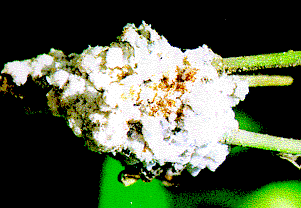
Pink Hibiscus mealybug, Maconellicoccus
hirsutus (Green)

What is this?
The pink hibiscus mealybug is a sap-sucking insect which is
typically observed as clusters of small soft-bodied insects in cotton-like masses covering buds, stems,
fruit, and roots, and in extreme cases the entire plant. The
insect has a life cycle of 24 to 30 days. The female mealybug
produces more than ten (10) generations per year in colonies of
500 eggs or more.
What it does.
This mealybug attacks more than 125 plant
species. It feeds on the sap of the plant and releases toxic
substances causing injury and death to the plant. It is spread by
wind, by ants, or it can be stuck on clothing or on the hair of
animals.
Signs of attack are easy to recognize.
One or more of the following symptoms may be seen:
- Crinkled or twisted leaves and shoots
- Bunched and unopened leaves
- Distorted or bushy shoots
- White fluffy mass on buds, stems, fruit, and roots
- Presence of honeydew, black sooty mold, and ants
- Unopened flowers which often shrivel and die
- Small deformed fruits.
Fruit trees attacked.
| Papaya |
Carambola |
Avocado |
Citrus |
| Sugar-apple |
Soursop |
Mango |
Breadfruit |
| Golden Apple |
Cherry |
Plum |
Guava |
| Pigeon Pea |
Passion Fruit |
Grape |
Banana |
Vegetables attacked.
| Tomato |
Cucumber |
| Pumpkin |
Peppers |
| Okra |
Dasheen |
| Lettuce |
Cabbage |
| Beans |
Squash |
Ornamentals attacked.
| Hibiscus |
Bougainvillea |
| Croton |
Oleander |
| Allamanda |
Ixora |
| Anthurium |
Ginger Lily |
| Heliconia |
Schefflera |
| Lantana |
Ficus |
| Seagrape |
Numerous Weeds |
The United States Department of
Agriculture in cooperation with the Florida Department of
Agriculture & Consumer Services seek your assistance to
prevent the introduction of the pink hibiscus mealybug into the
United States.
How you can help.
- Ensure that all plants, fruits, and vegetables brought
into the United States, particularly from Central America
and the Caribbean, are properly inspected and cleared at
U.S. ports of entry.
- Monitor all imported plants for white fluffy masses on
buds, stems, fruit, and roots.
- Report suspect pink hibiscus mealybug infestations to
your local office of the Florida Department of
Agriculture & Consumer Services-- Division of Plant
Industry, or your local USDA office.
HELP US PREVENT THE
INTRODUCTION OF THIS TERRIBLE PEST INTO THE UNITED STATES
For further information contact your local office of:
The United States Department of Agriculture
Animal and Plant Health Inspection Service
Miami: 305-526-2825
Orlando: 407-648-6856
The Florida Department of Agriculture & Consumer Services
Division of Plant Industry
Miami: 305-252-4360
Apopka: 407-884-2030
Gainesville: 352-372-3505
 Return to FSCA.
Return to FSCA.
 Return to MREC-ENTOMOLOGY- Common mealybugs that
attach foliage plants.
Return to MREC-ENTOMOLOGY- Common mealybugs that
attach foliage plants.



Return to MREC-ENTOMOLOGY- Common mealybugs that
attach foliage plants.
